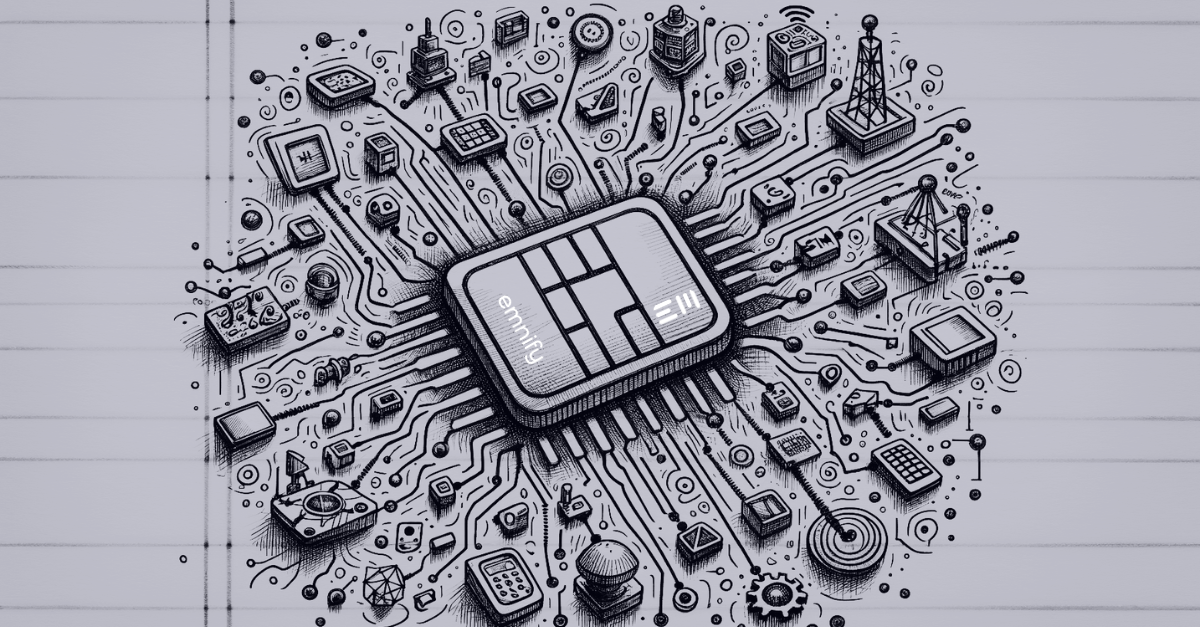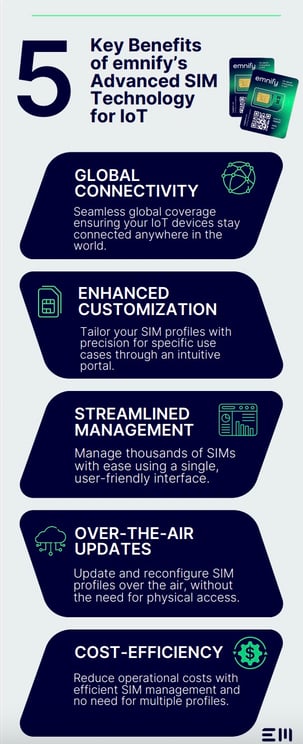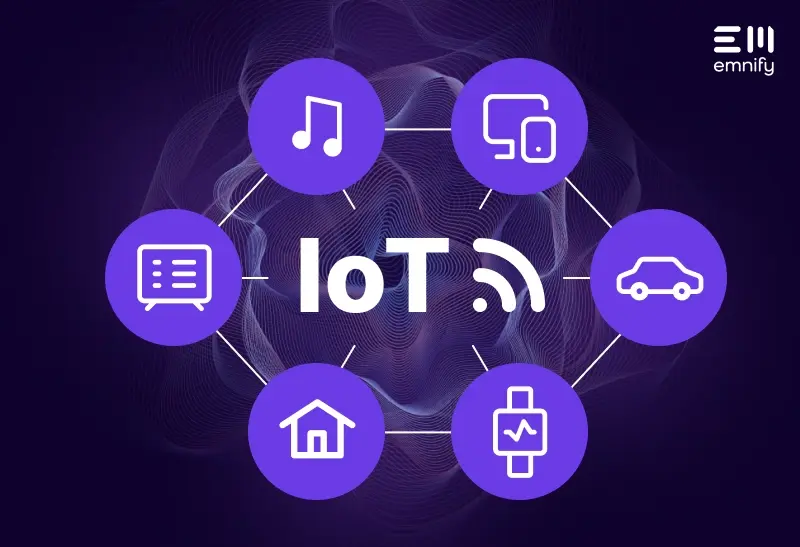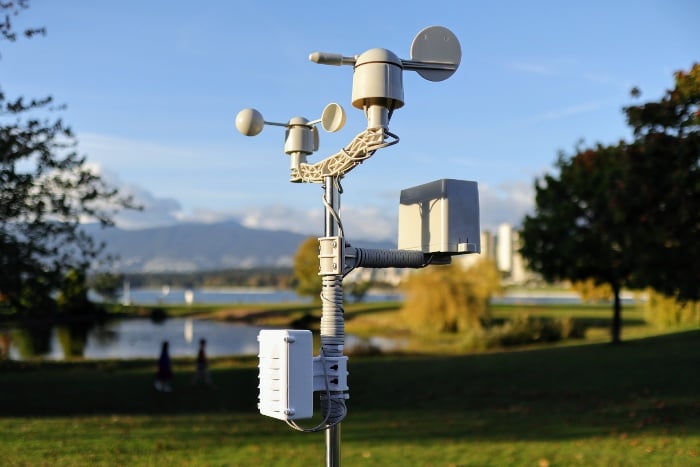

This matters to you because …
While many traditional providers turn to SIM profile orchestration as their default, emnify stands apart with a transformative approach: a single, consistent profile that offers customers extensive customization opportunities based on their specific use cases. This singular vision not only addresses the inherent limitations of traditional SIM cards built for mobile communication, but also sets the stage for a new era of IoT connectivity, where flexibility, efficiency, and strategic advantage converge.
The Subscriber Identity Module, or SIM, has become an essential component in modern mobility. Since the rollout of the earliest GSM networks (2G) in the 1990s, the SIM has been integral to mobile communications, now used by billions daily for connecting to cellular networks, making calls, and utilizing data services.
SIMs have also become a key ingredient of the IoT, connecting devices to cellular networks, to transmit and receive the data associated with machine-to-machine communication. For many, the SIM card is simply a piece of plastic that acts as a key, facilitating access to radio networks. However, its true capabilities, often underutilized, extend far beyond this simple description.
Challenges of traditional SIMs in IoT deployments
At its core, a SIM card is a gateway—a secure and encrypted connection to radio networks. It holds configurations that not only identify users within these networks but also specify which networks one can connect to. While most associate the term SIM card with its physical form, it’s more than that. It embodies a vital function and capability.
Over the years, SIM cards have evolved. From the credit card-sized ISO format to today’s nano-SIMs. Their physical properties have been altered to suit varying environments, from everyday consumer use to extreme industrial conditions with fluctuating temperatures and exposure to natural elements. It’s a testament to their importance that SIMs have been developed to withstand such diverse conditions.
Yet, even with advancements such as the embedded SIM (eSIMs) or virtual iSIMs, the production and issuance process for these cards remains antiquated and inflexible.
Traditional methods require a Bonding, Assembly, and Personalization (BAP) process that is inherently manual and labor-intensive. For each configuration change in a SIM profile, this arduous process involves programming new physical SIM cards, personalizing them, and then conducting manual network testing.
Such methods are not only time-consuming but also fraught with potential errors—errors that become exceedingly difficult to rectify after the cards have been deployed. This outdated method has led to a restrictive ‘one-size-fits-all’ approach within the industry.
For IoT applications, traditional SIMs introduce significant logistical and operational challenges:
Supply Chain Complexity: Pairing the SIM card with its respective device often takes place at different points in the supply chain, leading to logistical complications.
Carrier Lock-in: Switching mobile operators typically requires a physical SIM replacement—a task that’s not only logistically challenging but also poses security risks due to potential tampering or theft in accessible locations.
Despite their capabilities, SIM cards remain underutilized. Carriers, in their pursuit of security and operational convenience for themselves, have often restricted these capabilities, relegating the SIM to a gateway. This approach overlooks the potential of the SIM as an innovative tool that could empower the user, particularly in the context of IoT deployments.
This traditional perspective on SIM cards, while secure, lacks the adaptability and optimization necessary for the needs and sensitivities of the IoT sector. And this gap in the market demands attention.
The emnify approach to SIM card management
For emnify, and from my vision as co-founder, a SIM card is ultimately a function that can be tailored and optimized to fit specific needs, driving a unique, enhanced experience for our customers.
Historically, once SIM profiles were set, they remained unchanged. I’m proud to say that we’ve revolutionized that approach. As our SuperNetwork continues to expand, adding more radio network partners and broadening coverage, we’re also consistently enhancing our SIM profile. I’m not talking about minor adjustments. I’m talking about substantial, transformative updates that are rolled out across our entire customer base.
But our approach to SIMs extends beyond updates alone. We’ve democratized SIM customization in a way that’s unseen in the industry. Through our user-friendly portal and API, customers can directly adjust a range of settings: from network preferences and RAN selections to enabling specific modes like power-saving. While the backend complexities of these settings are vast, we’ve simplified the user interface, offering easy toggles and pre-configured options.
One might think that such profound customization would entail lengthy processes, significant costs, and the need for substantial orders. Not so. With emnify, customization is streamlined, whether you’re configuring a single SIM card or deploying changes across thousands.
emnify’s distinction with eUICC/eSIMs
emnify is the only company to ship eUICC/eSIM as a standard offering to all our customers. This is not a premium option or an additional cost feature; it’s our baseline, setting us apart from competitors who offer eSIM only as a costly optional extra.
How we use our eUICC technology is also an industry first. Traditionally, one Mobile Network Operator (MNO) profile was switched for another, however we leverage eUICC to perpetuate our single profile doctrine (discussed in detail below).
emnify’s ideal SIM profile is dynamic, undergoing constant updates. I don’t mean incremental OTA updates, I mean a complete profile overhaul when necessary, without the inconvenience of physical SIM swaps.
Sub-profile customization is another area where we lead. We enable our customers to create custom ‘sub-profiles’ tailored to their unique application and device needs, directly and efficiently. This means a single, adaptive profile for global connectivity that’s always current and always optimized for our customers’ specific use case.
Our single profile doctrine

Our single profile doctrine represents a fundamental shift in perspective. While many in the telecom sector use SIM profile orchestration, seeing it as an advancement, we at emnify view it as a continuation of outdated methods.
For the customer, SIM profile orchestration means navigating multiple profiles, and with each profile change, there’s often a change in the underlying core network. For instance, when a device moves from Europe to Brazil, a different profile is loaded, often accompanied by a shift to a different core network.
By implementing a single profile served by a single core network, we simplify the user experience. There’s no orchestration of multiple profiles, no manual swaps, and no shifts to different core networks with each location change. Customers enjoy a consistent, compliant, and efficient core experience, no matter where their devices are or what regional requirements they must meet. Everything is streamlined, uniform, and efficient.
The bottom line
I see a world where SIM card management is evolving, and emnify is at the forefront of this transformation. We’re not here to offer incremental improvements or to repackage old ideas in new covers. We’re here to redefine, innovate, and lead. While others might be content with orchestration, we see the future in a single profile - a singular vision for a connected world.
As I look to the future, it’s clear that the true power of IoT lies not just in connectivity but in smart, efficient, and adaptable connectivity. The choice between settling for the status quo and striving for innovation can make all the difference.
If you’re as passionate about the potential of IoT as I am, let’s connect. Discuss, challenge, and explore with me. Your next-gen IoT deployment deserves an architecture that’s just as forward-thinking.
Experience the power of the emnify IoT SuperNetwork
Every IoT use case is different, ranging from simple setups to complex global deployments. emnify offers flexible and scalable solutions that fit your needs.
Let's talk to discover how your business can leverage the power of the emnify IoT SuperNetwork.

Frank Stoecker
Frank Stoecker is CEO and co-founder of emnify. A successful serial entrepreneur and recognized telecoms expert for over 15 years, Frank anticipated early that the new wave of connected services demanded new concepts to simplify connectivity on a global scale. Prior to co-founding emnify, Frank held leadership positions at MACH and Syniverse.



